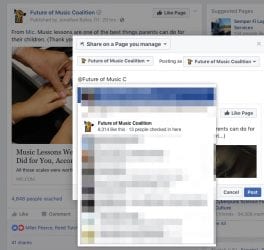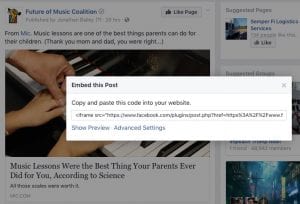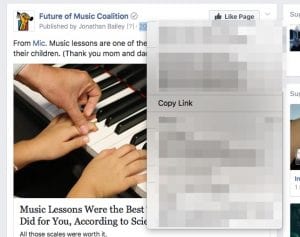Attribution and Citation on Facebook
How to share content ethically on Facebook...
 The rules of attribution are not universal. They change drastically based upon a variety of variables including time, topic and medium.
The rules of attribution are not universal. They change drastically based upon a variety of variables including time, topic and medium.
This means the requirements for attribution with a personal letter are not the same as a legal document, which isn’t the same as a research paper. This is something we generally know but don’t think about a great deal as usually make the switch instinctively.
While this makes sure that citation is appropriate for the medium its in, it does create a problem: How to handle giving credit on a new medium.
Social media is such a new medium. It’s an area where the citation standards are not very set and, in many cases, are actively in flux.
However, that doesn’t mean that the standards don’t exist.
In fact, the standards are often baked into the platforms themselves, becoming one of the social network’s features, rather than just a social norm.
With that in mind, we’re going to take a look at some of the largest social networks and their citation/attribution features. We’re also going to look at how they influences the social norms that have developed on their services and what the best practices for each are (at this time).
Hopefully, this will not only help move the conversation forward on what the attribution standards should be on social media, but also help find ways we can improve and codify the standards we have today.
Sharing
 Facebook is by far the largest social network in operation right now and, as such, plays a key role in setting the citation norms for all social media sites.
Facebook is by far the largest social network in operation right now and, as such, plays a key role in setting the citation norms for all social media sites.
However, Facebook came out of the box with one of the most popular social media attribution tools: The Share Button.
The Share button makes it easy for a Facebook user to take a post they see, whether its a friend or a page they follow, and re-share it with attribution. The attribution is tagged, making it so that a viewer can see the profile of the original submitter and there is a second link that goes to the post itself.
Things do get more complicated when one shares a post that was a share unto itself. Only the original post is attributed with the middle person not getting any credit. However, that may be the only practical alternative given the viral nature of some content on Facebook and the long chains of attribution it would leave behind.
However, sharing only looks at posts that are submitted to Facebook and then shared on Facebook (and only with minimal modification).
When it comes to bringing in outside content onto Facebook, things often get a bit more complicated.
Linking and Tagging
 When it comes to bringing in outside content to Facebook, the site provides a few tools to make sure that the content is properly attributed.
When it comes to bringing in outside content to Facebook, the site provides a few tools to make sure that the content is properly attributed.
The first is the most common of all citation methods on the internet: Linking.
Simply by pasting a URL, Facebook will convert it into a clickable link and, unless there is something else in the post that would prevent it, will show a preview of the page.
If you don’t wish to link to an external website but, instead, want to link to their Facebook page, that can also be achieved through tagging. Simply use the “@” symbol and begin typing the name of the user or the page. Eventually, Facebook should fill it in and let you tag them in the post.
This not only informs the person or page of the tag, but lets users go directly to the relevant page with just a click.
However, tagging has limitations, especially on Facebook Pages. If you’re trying to tag someone on a business page, you can only tag people you are personally friends with or other public pages. You can not tag a Facebook account you are not friends with.
Linking and tagging most commonly comes up with photo uploads. When sharing an image, Facebook users will often tag and/or link directly to the photographer. While this isn’t followed as regularly as one would like, Facebook certainly provides the tools to make it happen.
But then comes the issue of getting content out of Facebook and onto the broader web. This is an area where Facebook’s tools are limited, obtuse and far less helpful.
While it’s likely a bid to protect their walled garden, it has major implications for attributing and citing Facebook-posted content when it leaves the services.
Embedding and Linking to Posts
 Generally, Facebook is reluctant to make it easy for content posted on it to leave the service. However, they do provide two very important tools for sharing and attributing Facebook content outside of Facebook.
Generally, Facebook is reluctant to make it easy for content posted on it to leave the service. However, they do provide two very important tools for sharing and attributing Facebook content outside of Facebook.
The first, and most notable, is the Facebook embed feature.
On a public post, simply click the down arrow at the top right of the post and select “Embed”. This pulls up a pop up that lets you copy the HTML you need to embed the post onto your site.
This works well with almost any other kind of website, including WordPress and makes it trivial to place a full post into your site with proper attribution.
The other major tool is, once again, linking. However, here Facebook does a great job of hiding the feature, making it unclear where to find the link.
 However, every post on Facebook does have a unique URL. To find it, simply right click (or equivalent) on the timestamp for the post.
However, every post on Facebook does have a unique URL. To find it, simply right click (or equivalent) on the timestamp for the post.
From there, you can copy the link of the post itself and then paste it anywhere that you want.
Alternatively, you can simply click the timestamp and then go into your address bar and copy the link there.
Either way, you produce a link that will take a third party directly to the post that you are citing.
However, you have to bear in mind that what your visitors will see may be different from what you see. The reason is because of privacy settings and they, more than anything complicate attribution on Facebook.
A Note on Privacy
With Facebook, not every post, image or link is public. Many are shared to friends only or to a specific set of friends.
When a post has privacy restrictions on it, many of the most popular attribution tools are not available. You can not embed posts, you can not link to them and you can not share them outside of the predefined group of people who can see it.
There are ways you can get around this, such as taking a screen capture of the post, but those are generally considered poor form. Circumventing the privacy settings is generally seen to be as big of a faux pas as plagiarism itself on Facebook.
If you wish to cite a post that isn’t public, the best thing you can do is approach the author directly to see if and how they would be comfortable with you sharing the post.
Because, while attribution is certainly very important on Faceboook, it must be balanced by the privacy rights of the users you wish to cite. Not only will the technology work against you, but invading the privacy of your friends is also an ethical issue.
Simply put, when it comes to private communications and private posts, the best way to attribute them is to either get permission directly or find another source.
Bottom Line
Attribution on Facebook, especially when dealing with images, isn’t what it should be.
Far too much content circulates the site without proper attribution, whether its content from outside sources or content found elsewhere on Facebook.
However, it’s not because of a lack of effort on Facebook’s part. Facebook has worked to bake in attribution to every level of its network, turning it into a form of social discovery.
Whether it’s tagging, embedding, linking or sharing, Facebook provides a wide variety of tools to share content ethically both on its site and the larger web.
But despite that, those tools too often go unused. Though social norms on Facebook frown upon plagiarized posts, they also frown upon privacy violations.
In the end, Facebook’s attribution rules have two major limitations, the ethics of its users and its own privacy settings.
Finding the balance between attribution and privacy will be a major challenge for Facebook moving forward. However, it seems that the Facebook community is already working on these norms and will likely take the lead from Facebook itself.
If that happens, there’s not much doubt that new norms will emerge for the platform, which is exactly how it should be.
Want to Reuse or Republish this Content?
If you want to feature this article in your site, classroom or elsewhere, just let us know! We usually grant permission within 24 hours.
